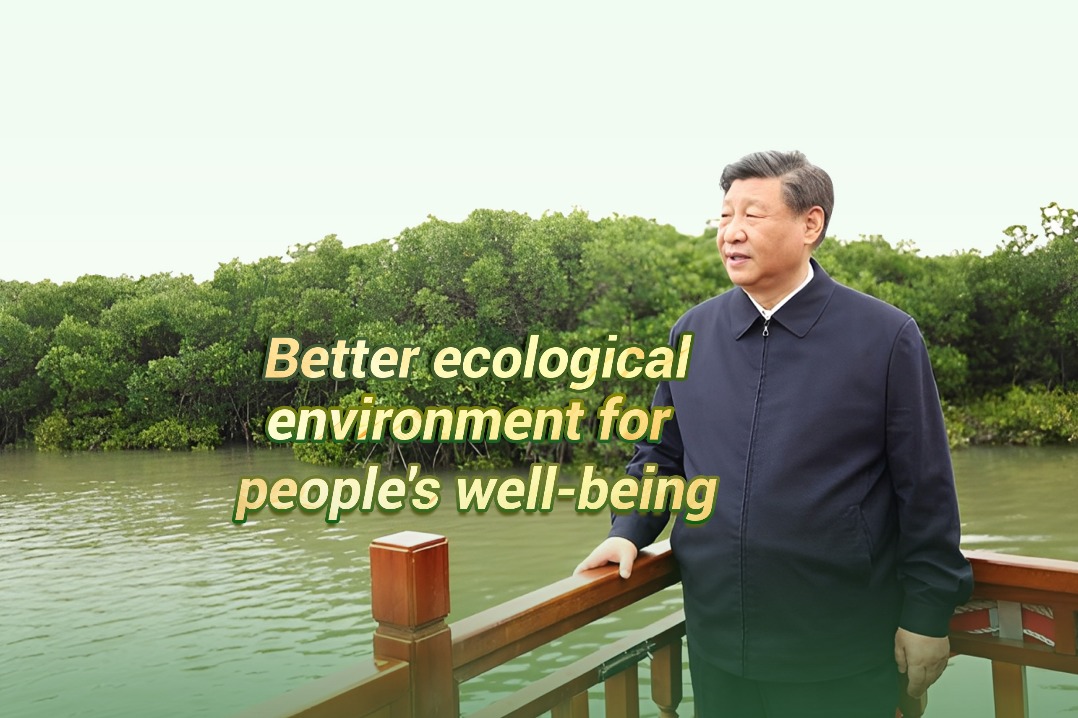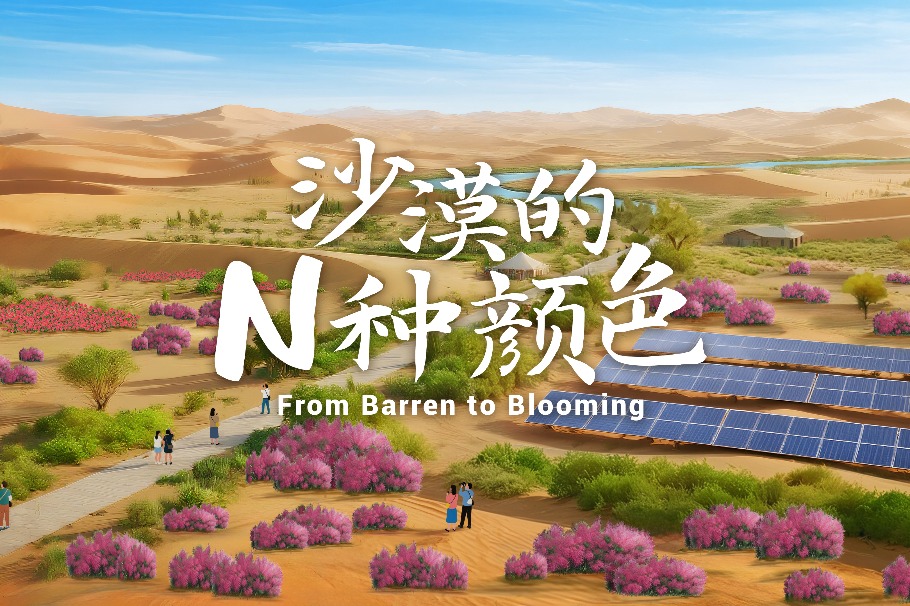From constraint to catalyst


Strategically upgrading its green supply chains in a changing global landscape will help China better cooperate with international partners and contribute to global sustainability in green industries
The Donald Trump administration's "reciprocal tariffs" have resulted in steep duties on nearly all major trading partners of the United States. This approach has amplified the structural vulnerabilities of global trade, posed significant obstacles to the global green transition and disrupted the smooth functioning of international value chains.
For China, in particular, these measures have raised short-term costs across its green supply chains. Greater uncertainties have arisen regarding China's role in global climate governance and the alignment between domestic green development and international low-carbon goals.
Trump's "America First" trade policy evolved from targeted tariffs under Sections 301 and 232 to a broader strategy combining tariffs, energy policies and permanent tax cuts. These have weakened the competitiveness of green products and hindered progress toward domestic and global climate goals. The unpredictability of US trade policies continues to present uncertainties that may affect the stability and growth of China's green supply chain in the global low-carbon transition.
China's trade exposure to the US has already declined notably. US-bound exports dropped from 21.6 percent of China's total trade in 2017 to 13.4 percent in 2024, while Chinese import dependence on the US decreased from a 19.2 percent share in 2018 to 14.7 percent in 2024. While this means the tariffs inflict acute financial pressure on some green product manufacturers and inject volatile cost signals, the broader integrity and international outreach of China's green supply networks remain relatively insulated.
Another challenge is the policy-driven disruption to China's green supply chain coordination with the global green transition. While the overall supply chain remains stable, key green technology sectors face cost pressures that may delay investments and capacity growth. China's solar industry shows resilience with expanding exports to diverse markets outside the US, reducing dependence on any single country. In lithium-ion batteries, despite the US being the largest export market, strong domestic firms with integrated supply chains and advanced technology mitigate tariff impacts. Although market diversification and technological strength help ease disruptions, adapting sales strategies and global positioning remains challenging, potentially slowing China's role in the global decarbonization effort.
Moreover, the ongoing uncertainty undermines China's ability to effectively engage in global climate governance. The resilience of its green supply chains is crucial for meeting its Nationally Determined Contributions and maintaining an active role in multilateral climate negotiations. However, escalating tariffs erode investment confidence, disrupt policy consistency, and create volatility in pricing — factors that complicate China's position in the international carbon markets, emissions monitoring and the dissemination of green technologies. Moreover, these trade tensions weaken commitments from both developing and developed countries, threatening to dilute global climate ambitions and weaken the stability of collective climate frameworks.
Confronted with these challenges, China will need to pursue both strategic and tactical reforms to improve and advance its green supply chains for the common global good.
First, export diversification should be prioritized. China should better align with and embrace multilateral frameworks and institutions, such as the Regional Comprehensive Economic Partnership, Comprehensive and Progressive Agreement for Trans-Pacific Partnership, Digital Economy Partnership Agreement, International Sustainability Standards Board and the Organization for Economic Cooperation and Development, to more effectively advance the Belt and Road Initiative and broaden green trade cooperation with participating countries and emerging markets across Asia, Latin America and the Middle East. By fostering deeper collaboration in renewable energy, green manufacturing and sustainable infrastructure, China can reduce its reliance on any single market, thereby cushioning its green exports sectors against asymmetric tariff shocks and ensuring more stable trade corridors.
Second, China should work more actively toward the joint development of international green standards, drawing on the experience of the European Union to enhance alignment and mutual recognition in global sustainability practices. Aligning carbon footprint accounting, sustainable sourcing and lifecycle management with frameworks such as the EU Battery Directive, the Carbon Border Adjustment Mechanism and the Corporate Sustainability Reporting Directive will be essential. Implementing on-chain carbon tracking, enforcing raw material traceability, and enhancing certification for low-carbon products will boost transparency, resilience, and competitiveness in stringent global markets.
Third, institutional capacity should be enhanced to foster resilient and well-coordinated green supply chains. This includes mandating green procurement, promoting green financing and deploying real-time data-sharing platforms powered by digital technologies. In response to tariff-induced disruptions, rigorous supply chain due diligence and eco-entry thresholds should be applied upstream to incentivize decarbonization across the value chain. Pilot programs for integrated digital platforms can break down information silos, improve resource allocation and strengthen risk management. Policy guidance, standardized regulations and targeted incentives will be vital to scale green logistics, production and procurement effectively.
Last, China could establish a rapid-response mechanism encompassing "Tariff Impact Assessment, Policy Reserve and Swift Reaction".Leveraging big data analytics, this system should forecast tariff trends and enable precise cost impact evaluations. For key industries such as solar, batteries, electrical machinery and textiles, scenario-based planning should provide information for differentiated tax relief measures. Developing cost-sharing frameworks within supply chains can help distribute tariff burdens, stabilizing operations. Simplifying cross-border trade through measures such as pre-clearance and regional exports return zones will reduce customs delays. Free trade zones should be leveraged to enable tariff-free imports of green technology inputs, support R&D hubs, and facilitate the transnational flow of low-carbon technologies. Together, these measures will build a resilient, policy-backed and service-oriented ecosystem that underpins China's green industrial growth.
China's green supply chains face complex external pressures that demand coordinated, multi-level responses. By diversifying markets, upgrading international compliance, strengthening institutional frameworks, and building agile policy mechanisms, China can safeguard the integrity and competitiveness of its green industries. These reforms will not only mitigate current tariff-induced risks but also enhance China's ability to lead the global low-carbon transition, promoting sustainable growth aligned with international climate commitments. Ultimately, these efforts will help China contribute more effectively to shaping resilient global green supply networks and driving inclusive, technology-enabled decarbonization worldwide.
Lu Jiajun is a researcher at the Academy of Financial Research and Zhejiang International Base for Science & Technology Exchange: Fintech and Big Data Analysis, and an assistant professor at Zhejiang University International Business School. Ben Shenglin is the dean and professor at Zhejiang University International Business School, and director at Zhejiang International Base for Science &Technology Exchange: Fintech and Big Data Analysis. The authors contributed this article to China Watch, a think tank powered by China Daily.
Contact the editor at editor@chinawatch.cn.


































